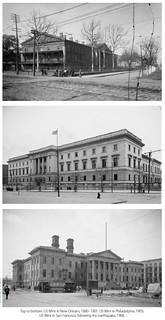
PREV ARTICLE
NEXT ARTICLE
FULL ISSUE
PREV FULL ISSUE
HISTORY OF THE US MINT’S LOCATIONSThe Spring 2017 issue of Financial History published by the Museum of American Finance includes a nice article by Michael A. Martorelli on the history of the U.S. Mint's
locations. Here is an excerpt. Pictured below at left is the first US Mint building in Philadelphia circa 1850–1860 (Library of Congress). -Editor
A History of the US Mint’s Locations
Following the American Revolution, government officials recognized the need for a standardized monetary system, and in 1781 the Articles of Confederation gave both Congress and the states the right to produce coins. However, none of the multiple varieties of coins struck by the federal or state governments or their authorized contractors achieved widespread circulation. In 1789, the US Constitution gave Congress the exclusive power to coin money, but it still took several years of study and deliberation before that body passed the first of many Coinage Acts. The new monetary system that law created was based largely on Secretary of the Treasury Alexander Hamilton’s January 1791 “Report on the Establishment of a Mint.” The April 1792 Coinage Act was officially named “An Act establishing a mint, and regulating the Coins of the United States.” It designated the US dollar as the standard unit of money, established the US Mint, authorized the production of coins in denominations ranging from a half cent ($0.005) to an eagle ($10) and detailed the standards for the production of America’s coins.
The first mint building was completed in September 1792, and two others followed in the next few months. The mint began producing copper coins in 1793; it added silver coins in 1794 and gold coins in 1795. The growing population’s strong demand for coins prompted the government to construct a larger production facility at the corner of Chestnut and Juniper Streets in Philadelphia in 1833. To ease production bottlenecks and meet the demand for coinage, President Andrew Jackson signed The Mint Act of 1835, which authorized the establishment of US Mint branches in Charlotte, North Carolina; Dahlonega, Georgia; and New Orleans, Louisiana. All three of these branches had rather limited lives. They were seized by the Confederate government during the Civil War, with officials continuing to produce coins for a short time. After the war, the US government decided to close the Charlotte and Dahlonega facilities. But in 1876, it gave the New Orleans branch another chance at life by reopening it as an assay office. In 1879, after refurbishing its minting equipment, officials re-commissioned the facility as a producer of silver coins. For the next 25 years, it was the largest producer of the famous Morgan silver dollar. The discovery of gold in California prompted the government to open another branch of the US Mint in San Francisco in 1854. In its first year of operation, the San Francisco Mint turned $4 million in gold bullion into coins. Growing demand from the western states prompted the government to build a larger San Francisco facility in 1874. This unusual building featured an enclosed central courtyard with a well. Within several years, this mint was producing more than 60% of the country’s gold and silver coins; its vaults became the repository for nearly one-third of the nation’s gold reserves. To read the complete issue, see:
 Wayne Homren, Editor The Numismatic Bibliomania Society is a non-profit organization promoting numismatic literature. See our web site at coinbooks.org. To submit items for publication in The E-Sylum, write to the Editor at this address: whomren@gmail.com To subscribe go to: https://my.binhost.com/lists/listinfo/esylum All Rights Reserved. NBS Home Page Contact the NBS webmaster 
|

